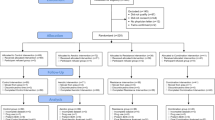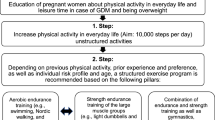Abstract
Objective:
To determine if physical activity delivered by an infant's mother would be as effective in promoting bone mineral acquisition in preterm very low birth weight (VLBW) infants as the same intervention administered by a trained therapist.
Patients and methods:
Preterm VLBW infants were randomized to receive daily physical activity administered by the infant's mother (MOM, n=11) or a trained therapist (OT, n=11), or control (n=11). Physical activity consisted of range of motion movements against passive resistance to all extremities for 5 to 10 min daily. All infants were fed mother's milk with fortification to 24 kcal oz−1. Dual energy x-ray of the forearm bone area (BA, cm2), mineral content (BMC, g), and density (BMD, g/cm2) and measurement of bone formation (bone-specific alkaline phosphatase, BAP) and resorption (urine pyridinium crosslinks of collagen, Pyd) were obtained at study entry and at 2.0 kg of body weight.
Result:
Forearm BA and BMC gains were greater in MOM and OT infants compared to the control infants despite similar postnatal growth rate and nutrient intake. Serum BAP levels decreased in controls but remained unchanged in MOM and OT infants. Urine Pyd levels were similar at baseline to 2.0 kg for all groups. These findings suggest greater bone growth and mineral acquisition in MOM and OT infants than control infants.
Conclusion:
This study demonstrates that a physical activity program administered by the infant's own mother is as equally effective as therapist-administered physical activity in promoting greater bone growth and mineral acquisition in preterm VLBW infants.
This is a preview of subscription content, access via your institution
Access options
Subscribe to this journal
Receive 12 print issues and online access
$259.00 per year
only $21.58 per issue
Buy this article
- Purchase on SpringerLink
- Instant access to full article PDF
Prices may be subject to local taxes which are calculated during checkout
Similar content being viewed by others
References
Rigo J, Pieltain C, Salle B, Senterre J . Enteral calcium, phosphate and vitamin D requirements and bone mineralization in preterm infants. Acta Pediatr 2007; 96 (7): 969–974.
Koo WWK, Sherman R, Succop P, Ho M, Buckley D, Tsang RC . Serum vitamin D metabolites in very low birth-weight infants with and without rickets and fractures. J Pediatr 1989; 114: 1017–1021.
Widdowson EM, Southgate DAT, Hay E . Fetal growth and body composition. In: Landblad BS (ed). Perinatal Nutrition. Academic Press: New York, NY, 1988, pp 4–14.
Koo WW, Walters JC, Hochnan EM . Body composition in human infants at birth and postnatally. J Nutr 2000; 130: 2188–2194.
Rigo J, Nyamagabo K, Picaud JC, Gerard P, Pieltain C, De Curtis M . Reference values of body composition obtained by dual energy radiograph absorptiometry in preterm and term neonates. J Pediatr Gastroenterol Nutr 1998; 27: 184–190.
Abrams SA, Schanler RJ, Tsang RC, Garza C . Bone mineralization in former very low birth-weight infants fed either human milk or commercial formula: one-year follow-up observation. J Pediatr 1989; 144: 1041–1044.
Kurl S, Heinonen K, Lansimies E . Pre- and post-discharge feeding of very preterm infants: impact on growth and bone mineralization. Clin Physical Funct Imaging 2003; 23: 182–189.
Fewtrell MS, Prentice A, Cole TJ, Lucas A . Effects of growth during infancy and childhood on bone mineralization and turnover in preterm children. Acta Paediatr 2000; 89: 148–153.
Weiler HA, Yuen CK, Seshia MM . Growth and bone mineralization of young adults bone preterm and <1500 g at birth. Early Hum Dev 2002; 67: 101–112.
Abou Samra H, Stevens D, Binkley T, Specker BL . Determination of bone mass and size in term, near-term, and preterm boys. J Bone Miner Res 2007; 22 (1): S231.
Yeh JK, Liu Cc, Aloia JF . Effects of exercise and immobilization on bone formation and resorption in young rats. Am J Physiol 1993; 264: E189–E198.
Rodriguez JI, Garcia-Alix A, Palacios J, Paniagqua R . Changes in the long bones due to fetal immobility caused by neuromuscular disease. A radiographic and histologic study. J Bone Joint Surg Am 1988; 70: 1052–1060.
Lickliter R . The role of sensory stimulation in perinatal development: insights from comparative research for the care of the high-risk infants. J Dev Behav Pediatr 2000; 21: 437–447.
Moyer-Mileur L, Leutkemeier M, Boomer L, Chan GM . Effect of physical activity on bone mineralization in premature infants. J Pediatr 1995; 127: 620–624.
Moyer-Mileur LJ, Brunstetter V, McNaught TP, Gill G, Chan GM . Daily physical activity program increases bone mineralization and growth in preterm very low birth weight infants. Pediatrics 2000; 106: 1088–1092.
Ferber SG, Kuint J, Weller A, Feldman R, Dollberg D . Massage therapy by mothers and trained professional improves weight gain in preterm infants. Early Hum Dev 2002; 67: 37–45.
Chan G, Moyer-Mileur L, Hansen J . Calcium and phosphorus requirements in bone mineralization of preterm infants. J Pediatr 1988; 133: 510–514.
Greer FR, McCormick A . Bone growth with low bone mineral content in very low-birth weight premature infants. Pediatr Res 1986; 20: 925–928.
Skovlund E . Truncation of a two sample sequential Wilcoxon test. Biom J 1991; 33 (3): 271–279.
Atkinson SA, Randall-Simpson J . Factors influencing body composition of premature infants at term-adjusted age. Ann N Y Acad Sci 2000; 904: 393–399.
Charoar Bm, Ruiz JG, Zupan J, Cattaneo A, Figueroa Z, Tessler R et al. Kangaroo mother care: 25 years after. Acta Paediatr 2005; 94: 514–522.
Kaaresen PI, Ronning JA, Ulvund SE, Dahl LB . A randomized, controlled trial of the effectiveness of an early-intervention program in reducing parenting stress after preterm birth. Pediatrics 2006; 118: e9–e19.
Horsman A, Ryan SW, Congdon PJ, Truscott JG, Simpson M . Bone mineral accretion rate and calcium intake in preterm infants. Arch Dis Child 1989; 64: 910–918.
Nemet D, Dolfin T, Litmanowitz I, Shainkin-Kester B, Eliakim A . Evidence for exercise-induced bone formation in preterm infants. Int J Sports Med 2002; 23: 82–85.
Crofton PM, Shrivasatava A, Wade JC, Stephan R, Kelnar CJ, Lyson AJ et al. Bone and collagen markers in premature infants: relationship with growth and bone mineral content over 10 weeks of life. Pediatr Res 1999; 46: 581–587.
Litmanovtiz I, Dolfin T, Regev R, Arnon S, Friedland O, Shainkin-Kestenbaum R et al. Bone turnover markers and bone strength during the first weeks of life in very low birth weight premature infants. J Perinat Med 2004; 32: 58–61.
Litmanovitz I, Dolfin T, Arnon S, Regev RH, Nemet D, Eliakim A . Assisted exercise and bone strength in premature infants. Calcif Tissue Int 2007; 80: 39–43.
Litmanovitz I, Dolfin T, Friedland O, Arnon S, Skinkin-Kestenbaum R, Eliakim A . Early physical activity intervention prevents loss of bone strength in very low birth weight infants. Pediatrics 2003; 112: 15–19.
Muller-Nix C, Forcada-Guex M, Pierrehumbert B, Jaunin L, Borghini A, Ansermet F . Prematurity, maternal stress and mother-child interactions. Early Hum Dev 2004; 79: 145–158.
Acknowledgements
Source of support: Primary Children's Medical Center Foundation.
Author information
Authors and Affiliations
Corresponding author
Rights and permissions
About this article
Cite this article
Moyer-Mileur, L., Ball, S., Brunstetter, V. et al. Maternal-administered physical activity enhances bone mineral acquisition in premature very low birth weight infants. J Perinatol 28, 432–437 (2008). https://doi.org/10.1038/jp.2008.17
Received:
Revised:
Accepted:
Published:
Issue Date:
DOI: https://doi.org/10.1038/jp.2008.17
Keywords
This article is cited by
-
Effect of physiotherapy on the promotion of bone mineralization in preterm infants: a randomized controlled trial
Scientific Reports (2022)
-
Effect of physical therapy on bone remodelling in preterm infants: a multicenter randomized controlled clinical trial
BMC Pediatrics (2022)
-
Effects of Maternal Exercise During Pregnancy on Perinatal Growth and Childhood Obesity Outcomes: A Meta-analysis and Meta-regression
Sports Medicine (2021)
-
Frühgeborenenmassage: taktile Körperstimulation in der Neonatalmedizin
Manuelle Medizin (2019)
-
Breech presentation is associated with lower adolescent tibial bone strength
Osteoporosis International (2019)



